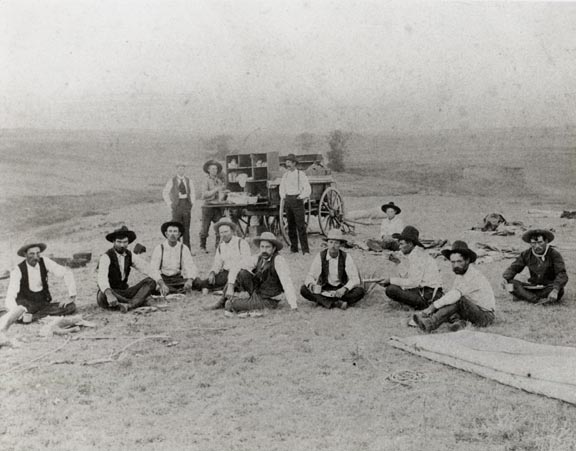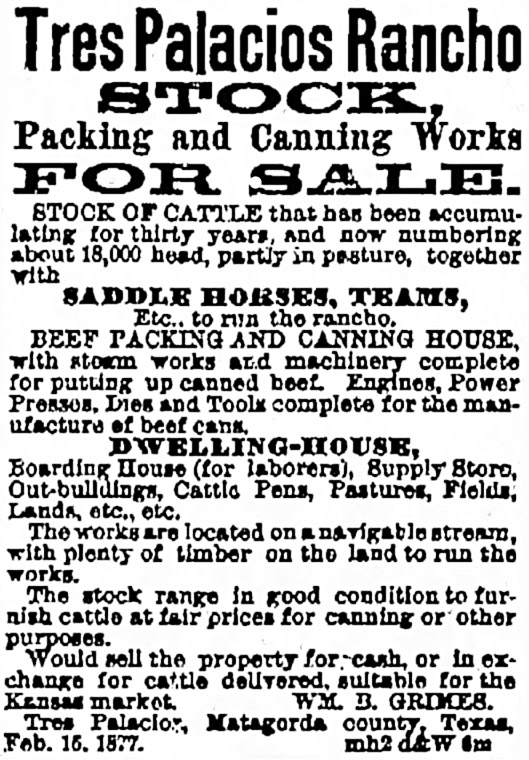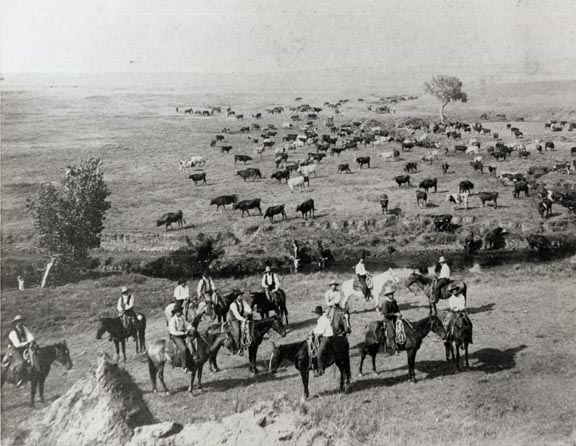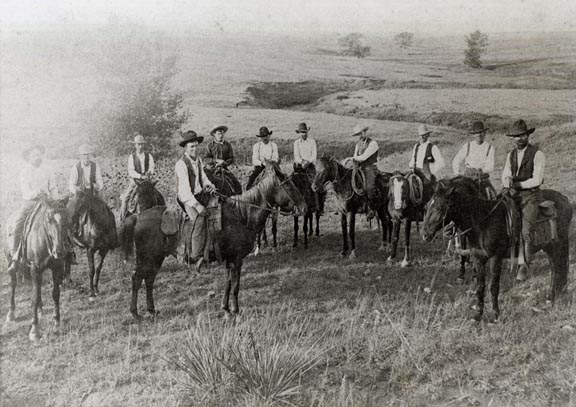|
BRADFORD ROBBINS GRIMES
On the Trail-Gulf to Dakota
“The WBG ranch kept from eight to
ten men busy branding the year around. The annual roundup began in
early Spring for it was traditional that herds start north not later
than the first week in April. The Chisholm Trail lay about ten miles
distant from the ranch. Let me tell you about a drive I made to
North Dakota.
“One day my father told me I was to
be top man or trail boss in charge of twenty-five hundred head of
cattle he was sending to our ranch in North Dakota, and that he
would pay me twenty-five dollars a month, and grub. Of course, I
felt mighty important as any boy in his early twenties would.
“When we started the round-up thirty
or forty men covered an area fifteen miles wide and rode between the
different creeks, Juanita, Colorado, Caranchua, Tres Palacios and
others. It didn’t take so very long before we had three thousand or
more head milling and bellowing close to the ranch, but it took us
some time to cut out those we were to drive north and brand them
with our trail brand “G.” In addition to the WBG ranch brand they
already carried.
“All cattlemen used a trail brand as
an extra precaution and for quick identification of stock that might
stray, become stolen, or get mixed with other herds on the way.
“We also rounded up a remuda of one
hundred extra horses which were pretty wild. We placed them in
corrals so that they could become acquainted with each other and
lose some of their wild notions before becoming a part of the trail
outfit.”
“A remuda was always placed in
charge of a horse wrangler who accompanied a drive and remained at
the rear of the herd. He was responsible for them. At night he tied
the horse he was riding with a long rope, which he attached to his
arm so that if the main bunch strayed while he was asleep, as it
always did, his horse would start to follow it, pull the rope and
awaken him.
“When the cattle were to be counted,
six men formed a lane through which the animals passed, sometimes
singly, sometimes, two, three, or four at a time. We used peas,
beans, or tied knots in strings to keep tab of the number of head.
When twenty-five hundred had been accounted for we turned the others
loose and headed them for the range.
“When all was in readiness for the
drive to begin, our crew consisted of fourteen riders, Oz, our
colored cook, who was in charge of the four mule chuck wagon, the
horse wrangler, who would not only have to look after the remuda but
rotate remounts for those horses that would become galled or tired
out, and myself. Seventeen men in all.
“Oz was one of our slaves. Where he
got the name of Osborn Williams I never knew until he told me one
day he had “just picked it up.” He was a flat-nosed fellow, a fine
cook, and a happy spirit. I can hear him singing, and I can hear the
tunes he played on his ten cent harmonicas which he always carried
with him.
“My father had furnished me with
money with which to buy foodstuffs to replenish our larder on the
way. Oz always felt very important to when telling me what was
needed. And he was an important member of the crew, for upon him
rested the responsibility for having meals ready to bolster up the
riders who were often tired out from lack of sleep and hard riding,
enervated by the hot dustladen winds that blinded them and the
cattle alike, or wearied by rains that made the trail a quagmire and
the going (trebly) terribly hard.
|

Picture courtesy of Robert M. Davant & Matagorda
County Museum. |
“When we left the ranch we had about
one thousand pounds of food supplies consisting of, in part, green
coffee, which we parched in a dutch oven, several sacks of sugar and
flour, bacon, rice, hominy, beans, and dried fruits. Oz always had
soda biscuits and flapjacks on the menu. Of course, we didn’t have
any printed menus. We just took what Oz gave us and ate it or went
hungry. Eggs were a few and great luxury. Rabbits, prairie chickens,
and antelope could be killed along the way if you were a good shot.
As I’ve said before, I don’t believe I was ever considered a good
marksman. ‘
“The smell of frying, bacon, the
odor of “dried salt,” which was the name we gave pork slabs, and the
aroma of boiling coffee, never failed to whet our appetites. We used
tin cups and tin plates.
“A twenty to thirty gallon barrel
was lashed on either side of the chuck wagon and filled with water
for drinking purposes. As we didn’t have any ice you can readily
understand how warm the water became. A poncho, or dried hide, was
slung under the wagon and filled with kindling. It was the duty of
Oz to replenish the supply of kindling with dried chips picked up
along the way as in many districts wood was priceless, and we had to
use it sparingly. But it was water first, last, all the time for man
and beast alike.
“The crew ate in turns as they
changed shifts, and Oz knew he would be busy from sunup to sundown,
and lots of times the boys would wake him up at night and tell him
they had to have grub.
“Our average move did not exceed
twelve miles per day. We always timed a drive so as to reach a creek
at about noon and another before dark, at which times we would throw
the herd off the trail to graze and water. When the noon stop was
made we left the herd in charge of just a sufficient number of me to
handle it while Oz went on ahead several miles and prepared dinner
for the others. When the men with the cattle reached Oz he was ready
for them and the others would be turned over to the boys who had
already had their dinner and the trek continued. Nightriders took
charge immediately after supper.
“Each rider had a yellow slicker, or
rain coat, two blankets and a tarpaulin which he laid on the ground,
if damp, or used with his blankets when nights were cold. And each
had his favorite horse.
“The trail was about on-fourth mile
wide and deeply rutted by the hoofs of the cattle which were always
wild and hard to handle at the start, but much more docile by the
time we reached Austin, Texas. Unless stampeded, they held the trail
fairly well. Always at the start one animal would take it upon
itself to be the leader of the herd, and no matter how often we
stopped for water and feed that critter would head the bunch again
when we started.
“We left the ranch on afternoon at
about four o’clock. Fifteen hundred miles lay ahead of us. None of
us knew that we would, but we hoped to reach our destination alive.
Dust storms, tornados, Indians, and renegades, were no strangers in
those days. We bedded down the first night we were out, and sunrise
next morning saw us well under way. We timed the day’s drive so as
to reach the Navidad River before sundown. We reached
it that evening, threw the herd off the trail and bedded down for
the night. In due time we passed close to Lockhart, Texas, and while
the herd continued its way, Oz and I bought about one hundred
dollars worth of supplies. Lockhart was then a nondescript
settlement of a few hundred people.”
“We reached Austin, Texas, about one hundred and
fifty miles from the ranch without anything special happening. I
paid of and turned back six riders as the cattle were giving little
trouble. Some of the boys who received part pay bought overalls or
shirts, or other wearing apparel, while others visited the saloons
and returned to outfit in a more-or-less worse for wear condition
but still quite able to sit in their saddles and nurse the herd. We
remained in Austin thirty-six hours during which time additional
foodstuffs were bought. The city then had a population of between
twenty and twenty-five thousand people.”
“Leaving Austin, we passed close to
Temple, Texas, without stopping, and when we reached Fort Worth,
about four hundred miles from home, we rested the stock and
purchased enough grub to carry us through to Dodge, Kansas.”
“When we crossed the Red River at Doan’s Ferry, so-called after a man by that name who operated the
ferry, we found ourselves in what was spoken of in those days as The
Beautiful Indian Territory.”
“Quanah Parker, a half-breed, was
head of the Comanche tribe. Quanah was waiting for us when we
stepped onto his land. I knew what was expected of me and did not
hesitate to hand him fifteen good dollars as a pourboire for good
will, which would permit me to feed and water the herd without being
molested as we passed through the Territory. He was most polite,
spoke excellent English, and when thanking me he assured me we would
not be harassed by his tribesmen. I have always believed he must
have had scouts out who promptly reported to him when a herd would
reach the river. He always met them on the north bank and collected
tribute.”
“When Indians asked cattlemen for an
animal they asked in wohaw, a word they had picked up from the
bullwhacker’s call to their long string of oxen freighting to
different army posts. “ Gee” turned the lead oxen to the right,
“Wohaw” swung them to the left. It was therefore easy for the
Indians to connect “wohaw” with beef, or cattle.”
“A few days after I had settled with
Quanah we were bedding down for the night at Cache Creek when
several Comanches rode up and demanded wohaw. Their spokesman was a
little yellow-faced half-breed and as evil looking as you can
imagine. I didn’t appreciate the demand for I felt I had already
settled with Quanah and that should be all that could be expected. I
told the Indian I had nothing to give him. He didn’t seem to care
what I said, and when I finally told him I had made peace with his
chief it had no effect. His demands became more insistent and I
became equally stubborn. In the end, he evidently thought he could
win me over by being more polite. He began to palaver and addressing
me we with the customary Indian salutation, said: “You heap good
chief.” “You good Texan.”
“I emphatically denied the
compliment. I thought I might scare him by letting him think I was
the worst bad hombre ever turned loose on the cattle trail, and
would stand no nonsense. But he wasn’t taken aback. He continued to
tell me what a heap good chief I was until I decided to get rid of
him by riding to the rear of the herd. But when he rode alongside me
I wondered what the outcome of the interview would be. I bandied
words with him as we rode. Before we reached the tail end of the
herd one of my riders overtook us and told me the other Indians were
talking about cutting the herd. I immediately rode back to find the
Indians bunched together and holding a pow wow.”
“It wasn’t long before the Indians
demanded, in one voice, “wohaw” and looked at me in such a way that
I felt cold chills running up and down my spine. Because of my
inexperience I determined to take a chance, I again refused the
demands. Had I been wise I would have given them a steer and they
would have been satisfied, while my refusal to do so might have as I
afterwards realized resulted in having the herd stampeded. Ringed by
my riders, who had their revolvers ready to shoot, we talked and
argued until I finally told them that if they caused me any trouble
they would have to make peace with Quanah. Whether or not Quanah
would or would not do anything, I didn’t know, but having taken a
stand I was determined to maintain it. What effect Quanah’s name had
on them, I don’t know to this day. Anyway, they finally decided to
leave. I returned to camp and laid down.”
“I became conscious during the night
that some one was moving close by. Opening my eyes I saw that evil
looking spokesman creeping up to my horse. Reaching it, he drew my
revolver from the saddle moral, a receptacle for odds and ends,
where I had foolishly left it. I could see him twisting the barrel
around to see if its chambers were loaded, and they were. I thought,
for sure my last hour had come. I sat up. My movement caused him to
look my way.”
“You good chief, me good chief, he
remarked, meaningly, and his ugly look emphasized his words.”
“I made no reply, and when my
silence must have nettled him he continued to assure me in lurid
language that I was a good chief.”
“You shoot me die, Me shoot, Me die.
All same you die,” he bluntly informed me, and I jumped to the
conclusion that he thought I had another gun. I didn’t tell him I
didn’t have one.
|




